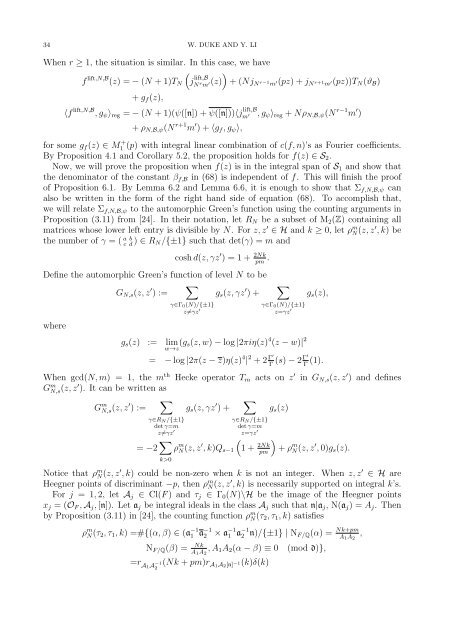Mock-modular forms of weight one - UCLA Department of Mathematics
Mock-modular forms of weight one - UCLA Department of Mathematics
Mock-modular forms of weight one - UCLA Department of Mathematics
Create successful ePaper yourself
Turn your PDF publications into a flip-book with our unique Google optimized e-Paper software.
34 W. DUKE AND Y. LI<br />
When r ≥ 1, the situation is similar. In this case, we have<br />
( )<br />
f lift,N,B (z) = − (N + 1)T N j lift,B<br />
N r m<br />
(z) + (Nj ′ N r−1 m ′(pz) + j N r+1 m ′(pz))T N(ϑ B )<br />
+ g f (z),<br />
〈f lift,N,B , g ψ 〉 reg = − (N + 1)(ψ([n]) + ψ([n]))〈j lift,B<br />
m ′ , g ψ 〉 reg + Nρ N,B,ψ (N r−1 m ′ )<br />
+ ρ N,B,ψ (N r+1 m ′ ) + 〈g f , g ψ 〉,<br />
for some g f (z) ∈ M 1 + (p) with integral linear combination <strong>of</strong> c(f, n)’s as Fourier coefficients.<br />
By Proposition 4.1 and Corollary 5.2, the proposition holds for f(z) ∈ S 2 .<br />
Now, we will prove the proposition when f(z) is in the integral span <strong>of</strong> S 1 and show that<br />
the denominator <strong>of</strong> the constant β f,B in (68) is independent <strong>of</strong> f. This will finish the pro<strong>of</strong><br />
<strong>of</strong> Proposition 6.1. By Lemma 6.2 and Lemma 6.6, it is enough to show that Σ f,N,B,ψ can<br />
also be written in the form <strong>of</strong> the right hand side <strong>of</strong> equation (68). To accomplish that,<br />
we will relate Σ f,N,B,ψ to the automorphic Green’s function using the counting arguments in<br />
Proposition (3.11) from [24]. In their notation, let R N be a subset <strong>of</strong> M 2 (Z) containing all<br />
matrices whose lower left entry is divisible by N. For z, z ′ ∈ H and k ≥ 0, let ρ m N (z, z′ , k) be<br />
the number <strong>of</strong> γ = ( a c d b ) ∈ R N/{±1} such that det(γ) = m and<br />
cosh d(z, γz ′ ) = 1 + 2Nk<br />
pm .<br />
Define the automorphic Green’s function <strong>of</strong> level N to be<br />
∑<br />
G N,s (z, z ′ ) :=<br />
g s (z, γz ′ ) +<br />
γ∈Γ 0 (N)/{±1}<br />
z≠γz ′<br />
where<br />
∑<br />
γ∈Γ 0 (N)/{±1}<br />
z=γz ′<br />
g s (z) := lim<br />
w→z<br />
(g s (z, w) − log |2πiη(z) 4 (z − w)| 2<br />
g s (z),<br />
= − log |2π(z − z)η(z) 4 | 2 + 2 Γ′ Γ′<br />
(s) − 2 (1).<br />
Γ Γ<br />
When gcd(N, m) = 1, the m th Hecke operator T m acts on z ′ in G N,s (z, z ′ ) and defines<br />
G m N,s (z, z′ ). It can be written as<br />
∑<br />
G m N,s(z, z ′ ) :=<br />
g s (z)<br />
γ∈R N /{±1}<br />
det γ=m<br />
= −2 ∑ k>0<br />
γ∈R N /{±1}<br />
det γ=m<br />
z=γz ′<br />
z≠γz ′ g s (z, γz ′ ) + ∑<br />
ρ m N(z, z ′ , k)Q s−1<br />
(1 + 2Nk<br />
pm<br />
)<br />
+ ρ m N(z, z ′ , 0)g s (z).<br />
Notice that ρ m N (z, z′ , k) could be non-zero when k is not an integer. When z, z ′ ∈ H are<br />
Heegner points <strong>of</strong> discriminant −p, then ρ m N (z, z′ , k) is necessarily supported on integral k’s.<br />
For j = 1, 2, let A j ∈ Cl(F ) and τ j ∈ Γ 0 (N)\H be the image <strong>of</strong> the Heegner points<br />
x j = (O F , A j , [n]). Let a j be integral ideals in the class A j such that n|a j , N(a j ) = A j . Then<br />
by Proposition (3.11) in [24], the counting function ρ m N (τ 2, τ 1 , k) satisfies<br />
ρ m N(τ 2 , τ 1 , k) =#{(α, β) ∈ (a −1<br />
1 a −1<br />
2 × a −1<br />
1 a −1<br />
2 n)/{±1} | N F/Q (α) = Nk+pm<br />
A 1 A 2<br />
,<br />
N F/Q (β) = Nk<br />
A 1 A 2<br />
, A 1 A 2 (α − β) ≡ 0 (mod d)},<br />
=r A1 A −1(Nk<br />
+ pm)r A<br />
2 1 A 2 [n] −1(k)δ(k)
















